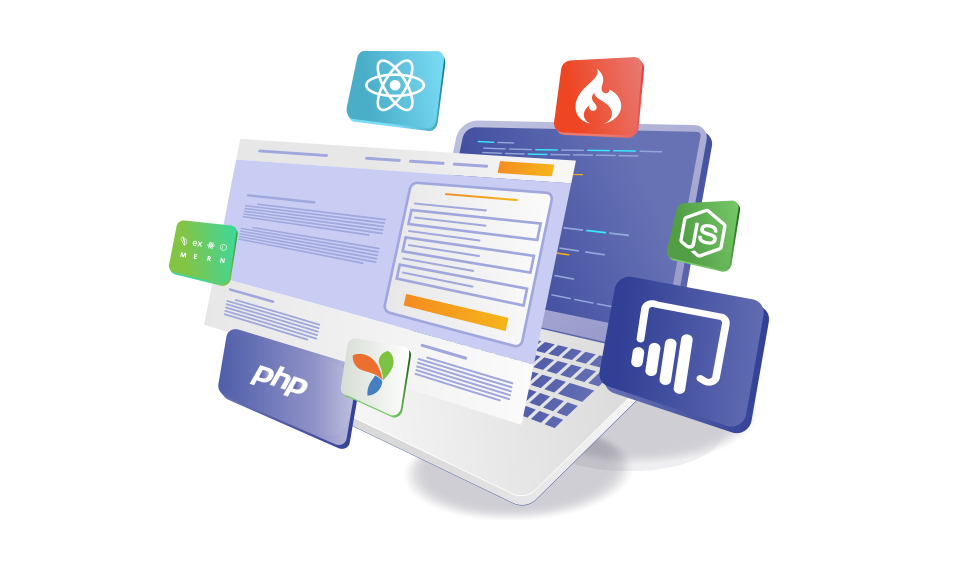React Native Development
React Native is an open-source mobile application development framework based on ReactJS. It allows developers to create mobile applications for iOS and Android using JavaScript and a similar component-based approach as ReactJS.
Critical features of React Native
- Cross-Platform Compatibility: React Native allows developers to create applications for both iOS and Android platforms using a single codebase. This means that developers can write once and deploy on both platforms, which reduces development time and cost.
- Native Performance: Unlike traditional hybrid app frameworks, React Native uses native components to render the user interface. This makes the application run smoothly and with native performance, providing a better user experience.
- Hot Reloading: React Native has a feature called Hot Reloading, which allows developers to see the changes they make in the code in real-time without recompiling the entire application.
- Third-Party Libraries: React Native has a vast collection of third-party libraries and modules, making adding new features and functionalities to the application easy.
- Community Support: React Native has a large and active community of developers, which provides support and resources for developers to learn and use the framework.
Use cases of React Native
- E-commerce Apps: React Native is suitable for building e-commerce applications, which require a lot of interactive features and a smooth user experience.
- Social Media Apps: React Native is a great choice for building social media apps requiring real-time updates and much user engagement.
- Travel Apps: React Native is an excellent choice for building travel apps requiring location-based services and real-time updates.
- Gaming Apps: React Native can be used to build gaming applications requiring smooth performance and high responsiveness.
React Native Development Platform
To develop mobile applications using React Native, developers require the following platforms:
- Node.js: Node.js is a JavaScript runtime environment required to install React Native and its dependencies. It provides features like network communication, file system access, and process management.
- React Native CLI: React Native CLI is a command-line interface for creating and managing React Native projects. It can be installed using Node Package Manager (npm).
- Android Studio or Xcode: Android Studio and Xcode are the official Integrated Development Environments (IDEs) for Android and iOS platforms. They provide tools for developing, testing, and debugging mobile applications.
- Android Emulator or iOS Simulator: To test the application on a mobile device, developers can use an emulator or simulator with Android Studio or Xcode. These emulators and simulators provide an environment to test the application without needing a physical device.
- Code Editor: A code editor is required to write and edit the code for the application. Some popular code editors used for React Native development include Visual Studio Code, Atom, and Sublime Text.
- Debugger: Debugging tools are essential to identify and fix errors in the application. React Native Debugger is a popular debugging tool that can be used for React Native development.
- Package Manager: React Native uses npm or Yarn as a package manager to install and manage dependencies for the application.
React Native Development Steps
React Native is an open-source mobile application development framework based on ReactJS. It allows developers to create mobile applications for iOS and Android platforms using a single codebase. Here are the steps involved in React Native development:
- Set up Development Environment: To start developing a React Native application, developers must set up their development environment. They must install Node.js, React Native CLI, Android Studio or Xcode, a code editor, and a debugger.
- Create a New Project: Using the React Native CLI, developers can create a new project by running a command in the terminal. This creates a basic project structure with all the necessary files and folders.
- Design the User Interface: React Native provides a set of pre-built components that can be used to design the application's user interface. Developers can use these components to create a responsive and interactive user interface.
- Add Functionality: To add functionality to the application, developers must write JavaScript code. They can use various libraries and modules to add features such as network communication, data storage, and user authentication.
- Test the Application: Once developed, developers must test it on various devices and platforms. They can use emulators or simulators provided by Android Studio or Xcode to test the application without needing a physical device.
- Deploy the Application: After testing, the application can be deployed to the respective app stores (Apple App Store or Google Play Store). Developers must follow the guidelines and rules the app stores provide to apply.
Best practices for React Native development
- Use Redux for State Management: Redux is a popular state management library that can manage the application's state in a predictable and centralized way.
- Optimize Performance: To ensure the application runs smoothly, developers must optimize its performance. They can use tools like React Native Performance Monitor to identify and fix performance bottlenecks.
- Use Native Modules: React Native allows developers to use native modules written in Java or Swift. This can be useful for implementing complex features unavailable in the React Native library.
- Use Third-Party Libraries: React Native has a vast collection of third-party libraries and modules that can add new features and functionalities to the application.
In conclusion, React Native is a robust framework for developing mobile applications for both iOS and Android platforms. By following best practices and using the right tools and libraries, developers can create high-quality applications with excellent user experiences.



